This puzzle presents itself as a set of dots and a message. With some effort, the message reads CONNECT THE DOTS DON'T FORGET TO LOOP AROUND.
Each dot is associated with a single word. These words form specific groups with no real common theme. With a lot of effort, we can form groups with these words. While forming groups, we notice that the red-colored dots, numbered 1 through 10, are each in unique groups. This can be helpful in finding groups and ordering them.
These groups are quite hard to find on their own. In the third column below, we list some ways of finding each set, along with some useful webpages. In general, we can rely heavily on our knowledge or OneLook to form word associations, Wikipedia disambiguation pages to find other meanings for seemingly common words, and extensive use of search engines, e.g. Googling multiple words together.
| Category | Items | Explanation |
|---|---|---|
| Balls | (1, base), (19, soft), (26, paint), (41, foot), (51, paddle), (53, calvin), (59, golf), (63, dodge) | There are several common ones that are recognizable (foot, ball, soft, base, dodge). The tricky part is finding all of them. Tools like OneLook can be helpful in finding words that precede "ball". Calvinball is a fictional game from Calvin and Hobbes. |
| One Direction Songs | (2, strong), (17, diana), (23, home), (25, infinity), (27, perfect), (42, happily), (56, history) | These are hard to recognize. Searching several of them together (with quotes around the words to get exact string matches) should start to surface One Direction Discography Wikipedia or lyrics pages. |
| Types of sewing stitches | (3, ladder), (16, overcast), (24, zigzag), (36, chain), (38, tent), (60, running) | This Wikipedia page for types of sewing stitches lists all of them. We can find this page by looking at the disambiguation page for something like Chain. |
| Codenames of members of X-Men | (4, darwin), (12, thunderbird), (28 husk), (32, sage), (66, angel) | This Wikipedia page lists all the X-Men. The disambiguation page for some of these, e.g. Thunderbird, hints at Marvel superheroes. |
| Towns and villages in Ireland | (5, cork), (18, boston), (20, hospital), (33, drum), (37, limerick), (40, swords), (45, inch), (57, ovens) | This page lists all the towns and villages in Ireland. Some may recognize Cork and Limerick as major Irish cities, and find further confirmation with Swords. |
| Types of grains | (6, rye), (14, teff), (30, maize), (49, spelt), (50, barley), (55, oats) | Several grains (rice, oats, rye, maize) are common enough that this group should be fairly easy to confirm. Several pages (e.g. this page on grains) lists types of cereal grains. |
| Parts of a fountain pen | (7, section), (15, barrel), (21, nib), (31, converter), (39, feed), (43, cap) | We can get this one by asking "what is a nib?" Other ways may involve searching several of these terms together, which brings up pages like this one which includes a diagram. |
| Git commands | (8, bisect), (34, add), (46, branch), (48, clone), (52, stage), (58, merge) | We can find this one by searching some terms (bisect, clone) together. Many may also recognize common git commands like "add" and "clone", with clone sticking out quite a bit. This manual page for git lists most of the commands, though the best way to get all the commands (and find git-stage) is to run git --help -a on the command line. |
| Types of video game currencies | (9, gold), (11, rings), (13, kudos), (29, souls), (54, bells), (62, coins) | Several of these are plural and feel like they should go together. In particular, gold and coins are ubiquitous in many games, especially RPGs. Specifically, coins are also found in Mario games, rings in Sonic games, souls in Dark Souls, Bells in Animal Crossing, and Kudos in Fall Guys. Some webpages list various video game currencies, but nothing is complete. |
| Words that can follow egg | (10, timer), (22, cup), (35, rolls), (44, cell), (47, man), (61, noodle), (64, tooth), (65, yolk), (67, plant) | Some words like yolk, cell, noodle, and rolls (plural) hint at egg. The complete set can be found with a tool like OneLook. In particular, Eggman is a character from Sonic games, Egg timers are cute timers used for cooking eggs, and egg teeth (or an egg tooth) are used by birds to break out of their shells. |
Connecting the dots in increasing numerical order (and "looping around" by connecting the highest number to the lowest one) forms shapes looking like the following:
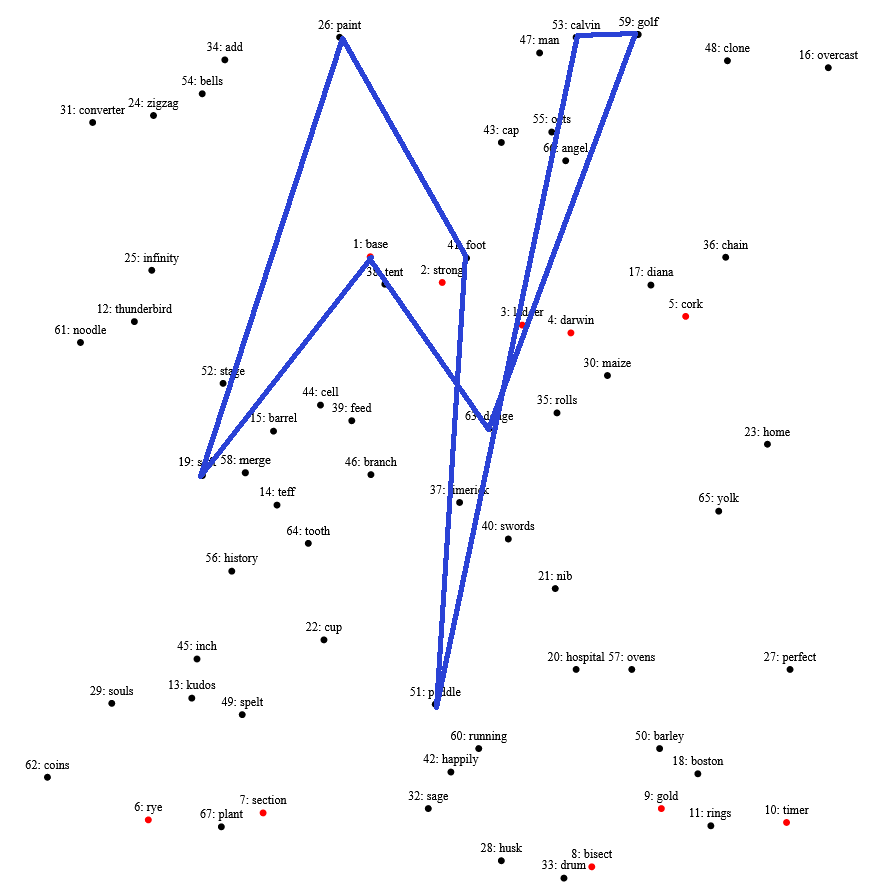

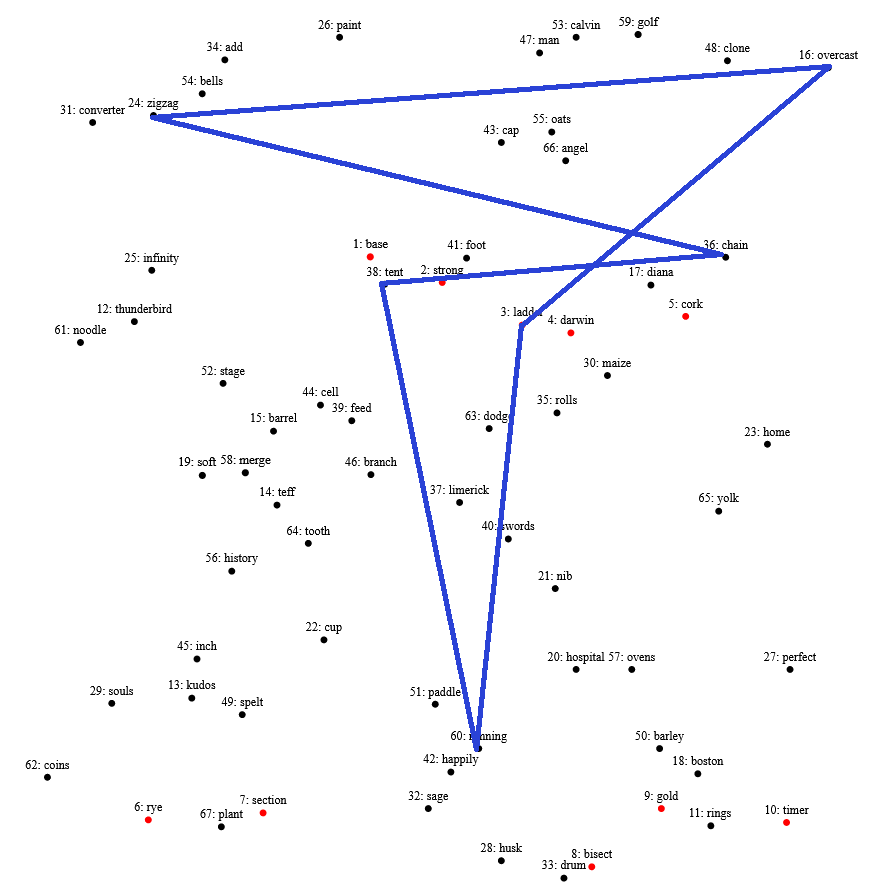
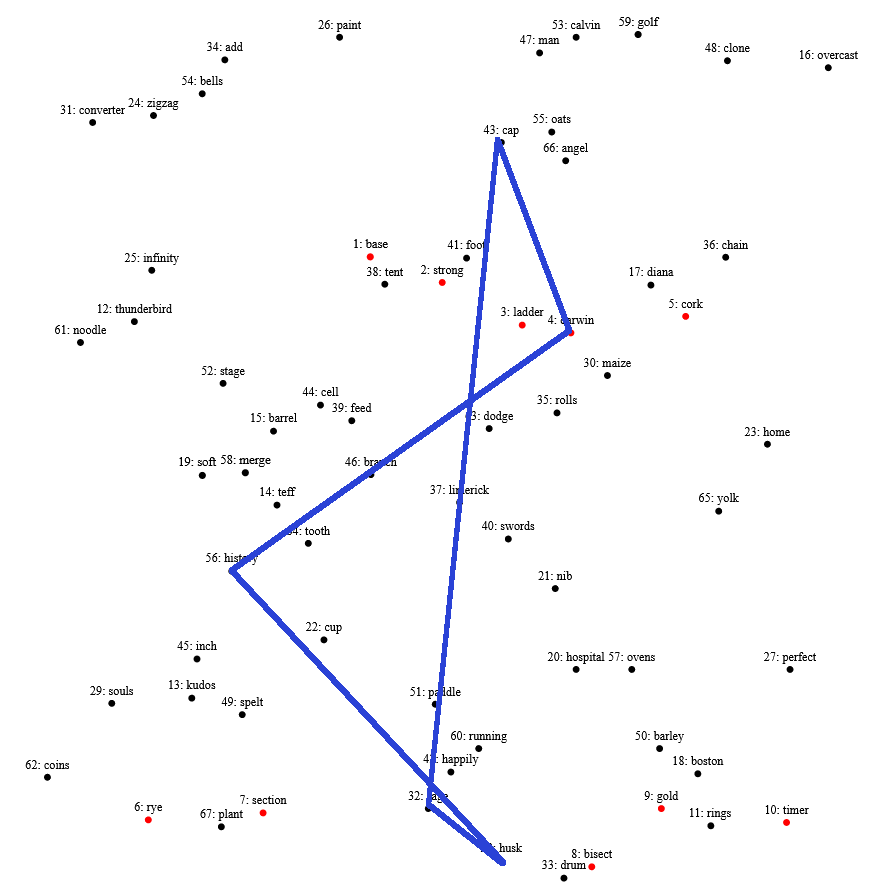
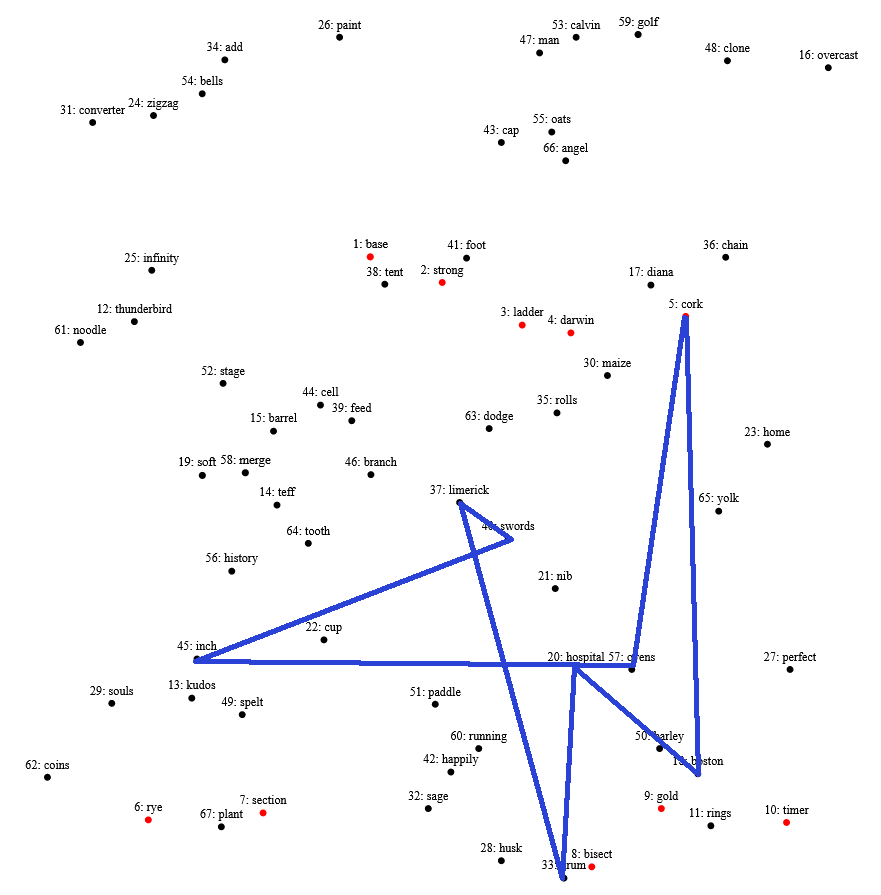
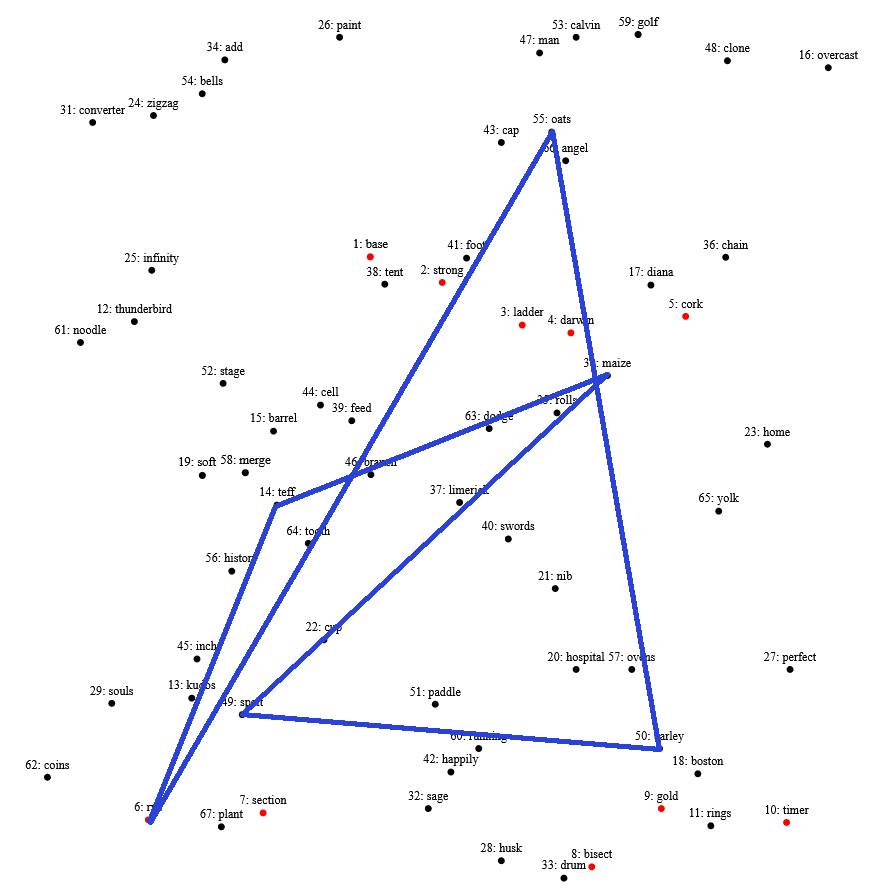
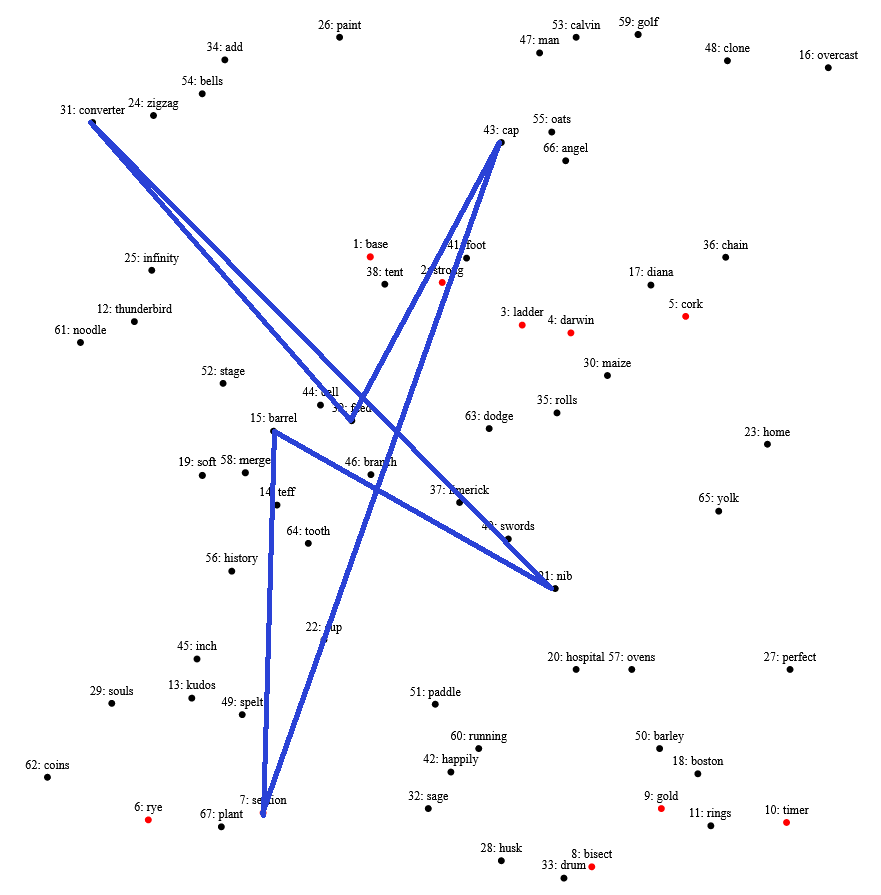
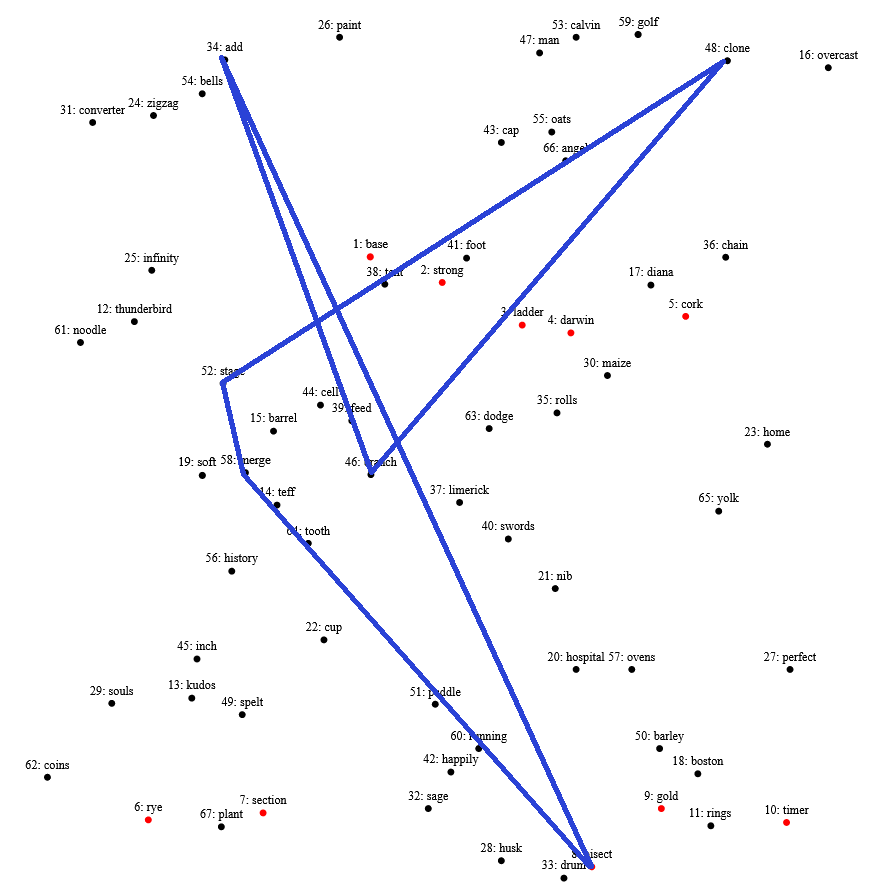
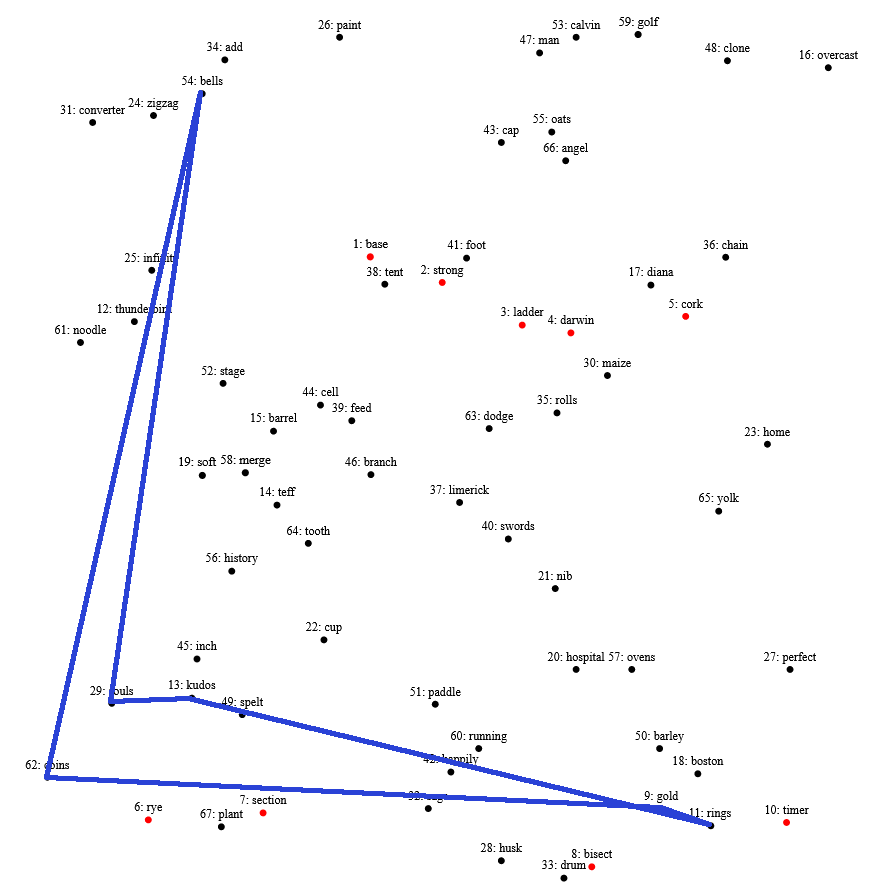
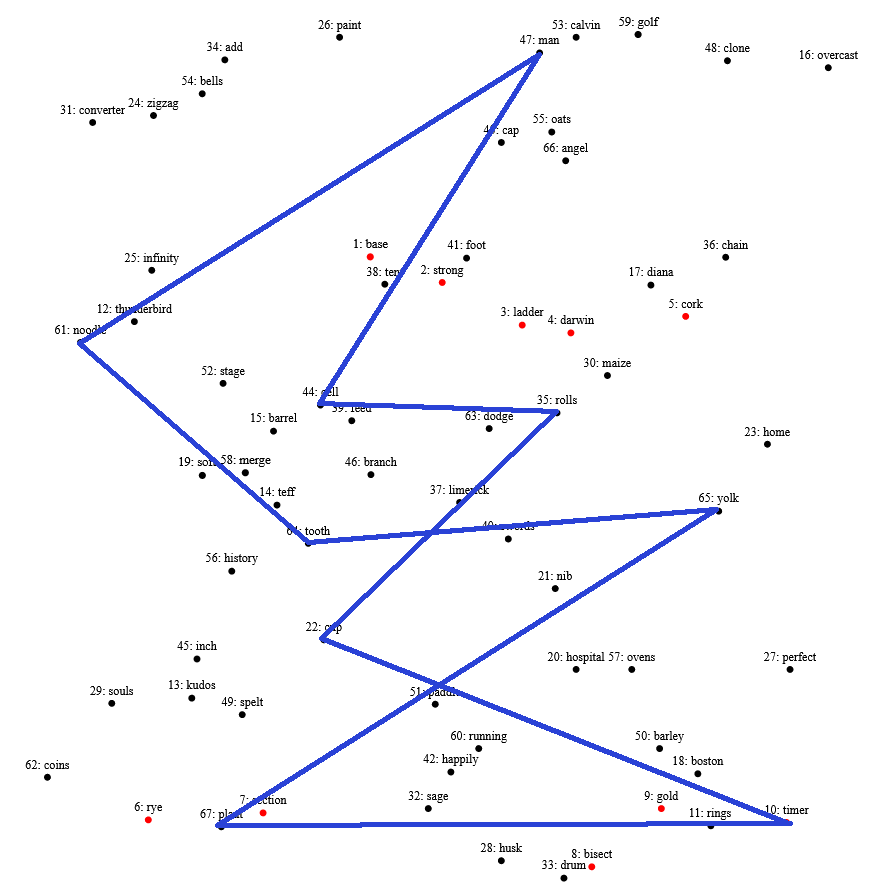
We can try to read these letters, especially since they look smilar to the letters in LOOP AROUND. Once again with some effort, we read NOT IN CYCLE. Looking closer, in each shape there’s exactly one point that can be removed from each letter to form clean letters with no crossing lines. This was also true in the letters of LOOP AROUND: one point can be removed such that the remaining shape has no crossing lines.
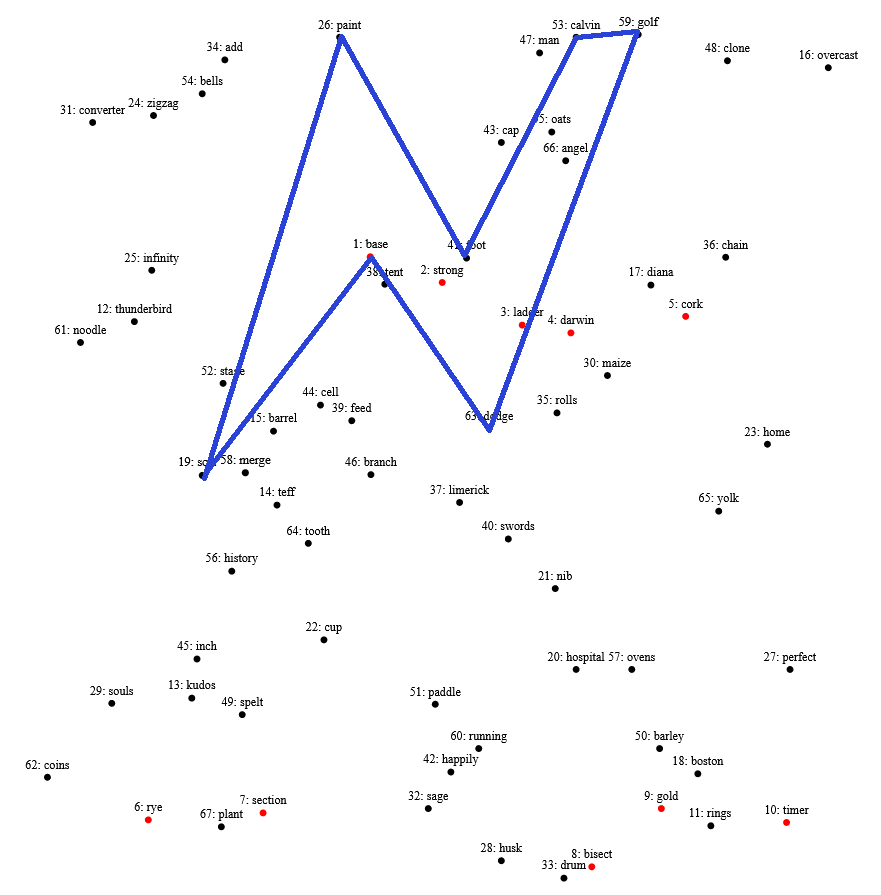
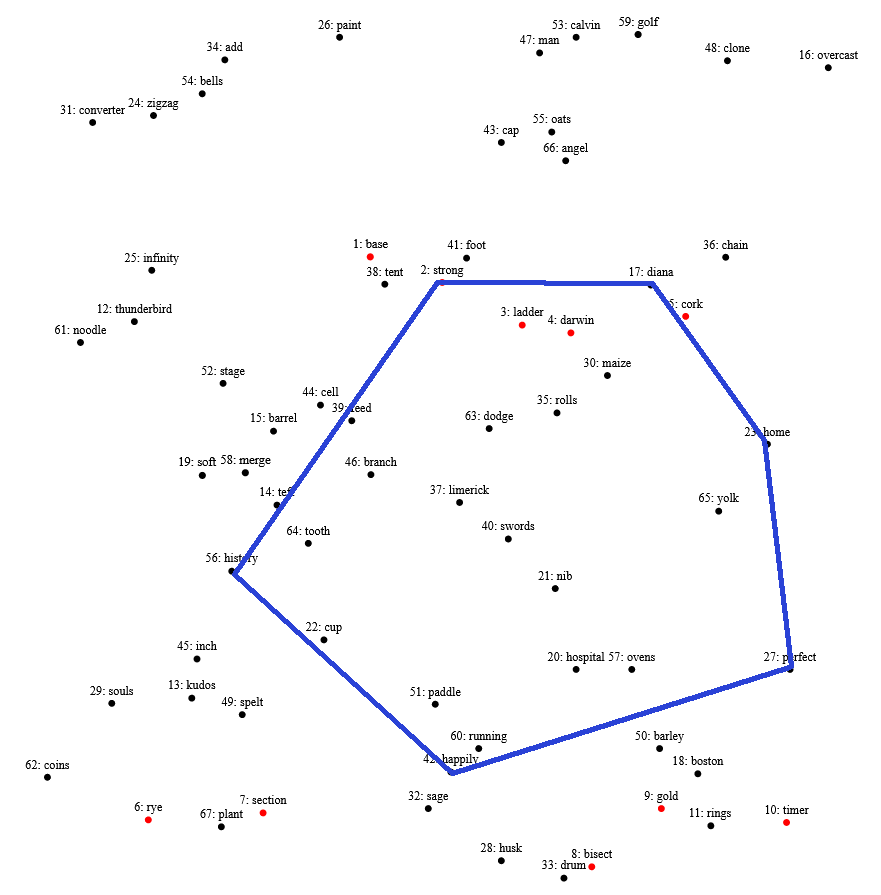
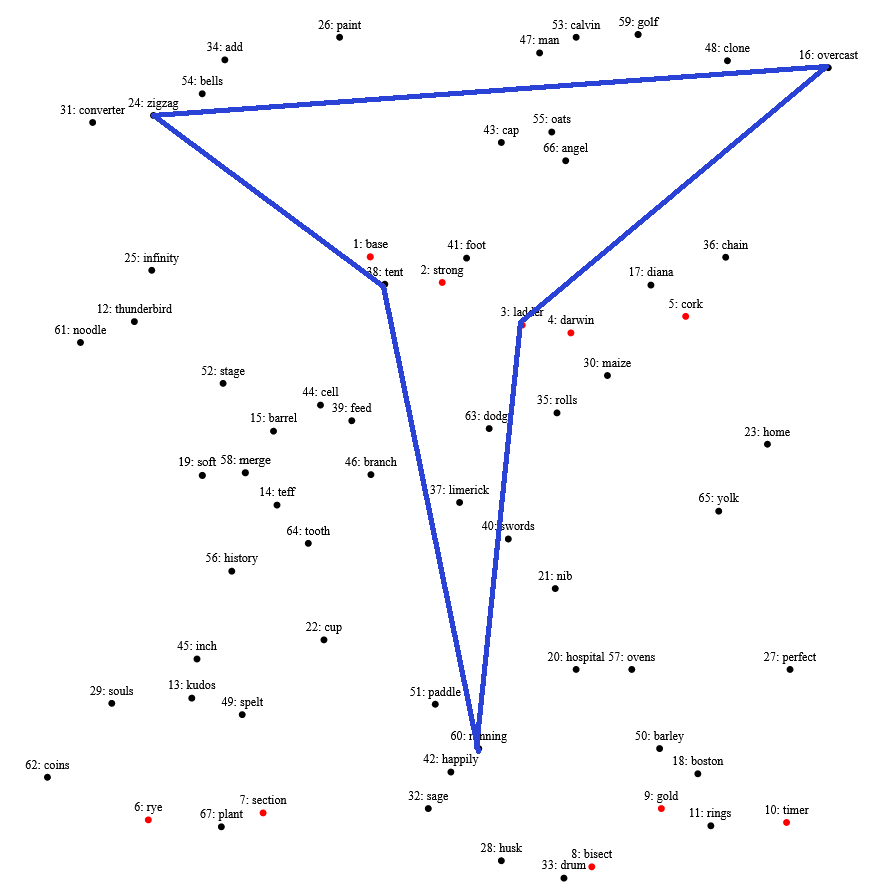
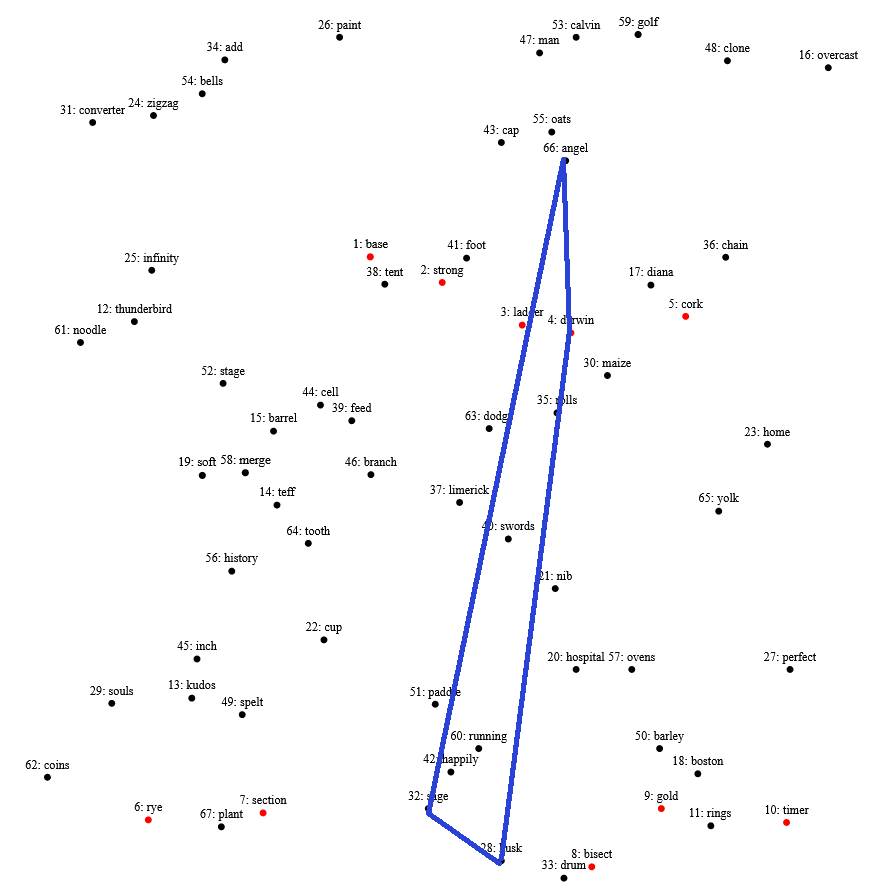
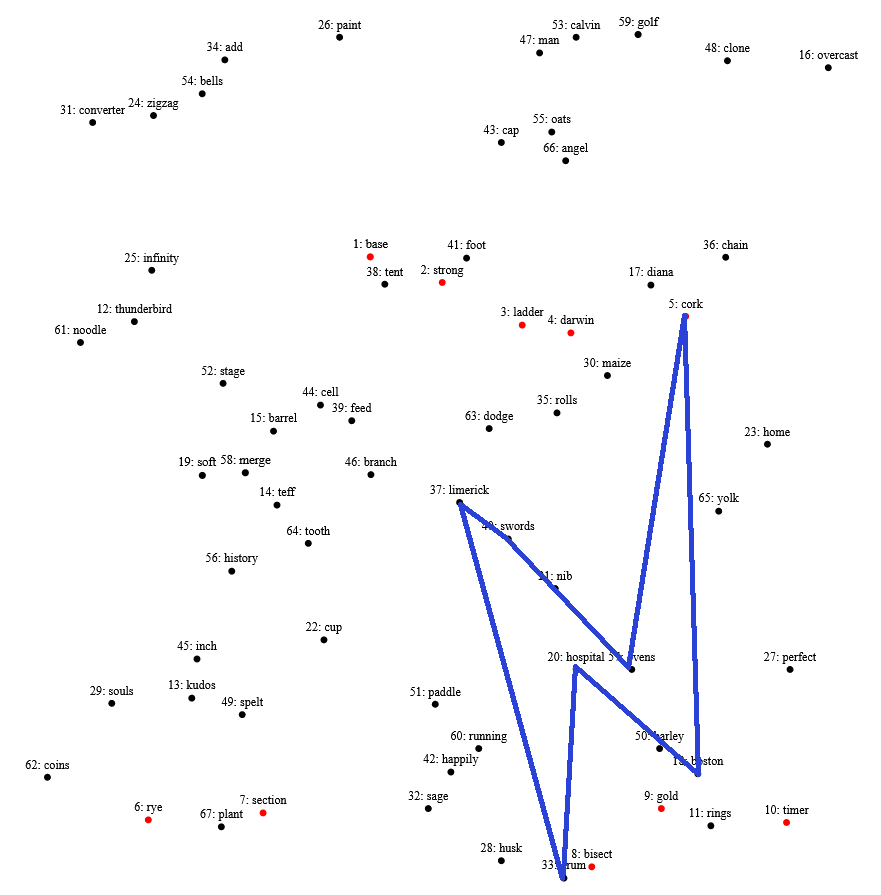
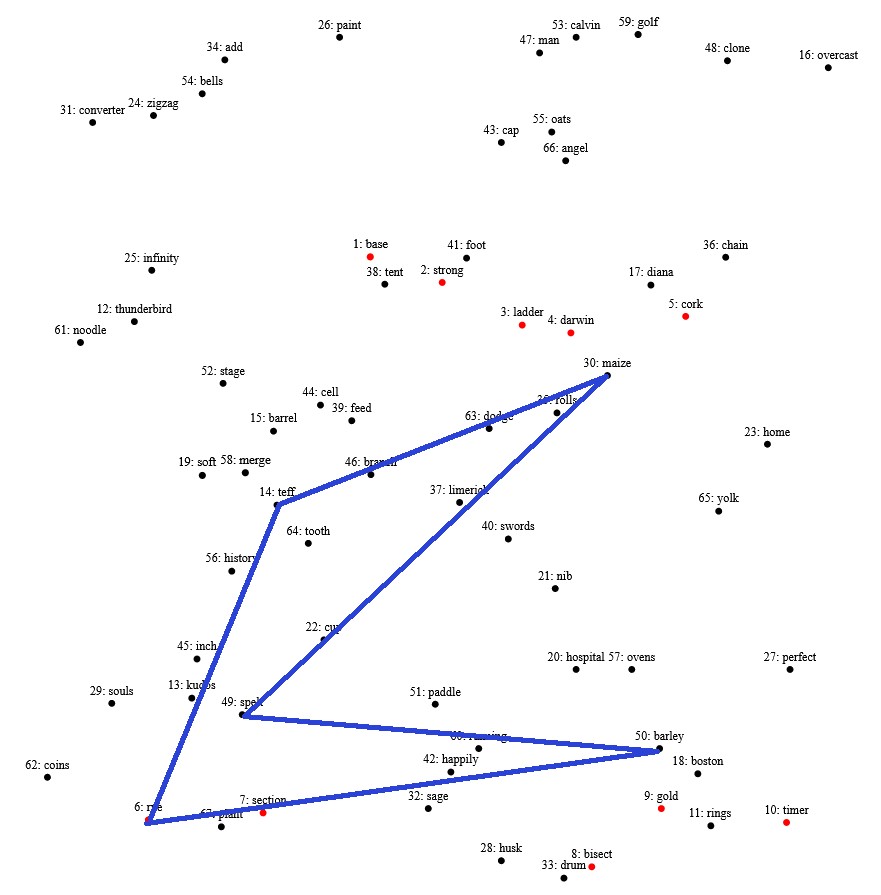
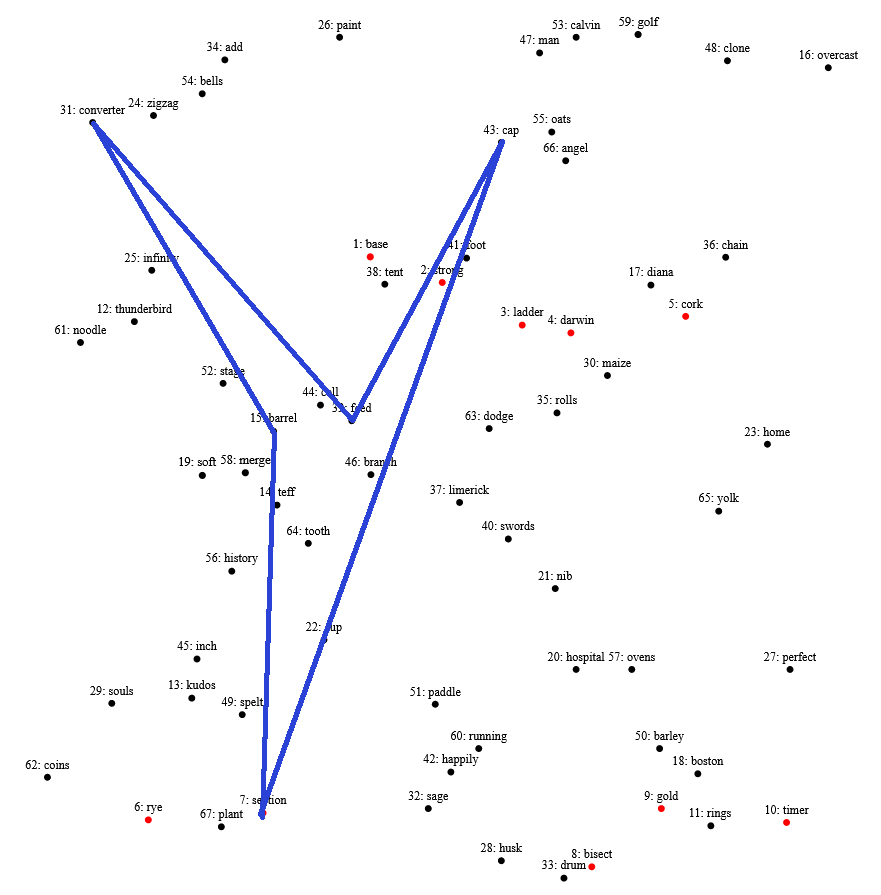
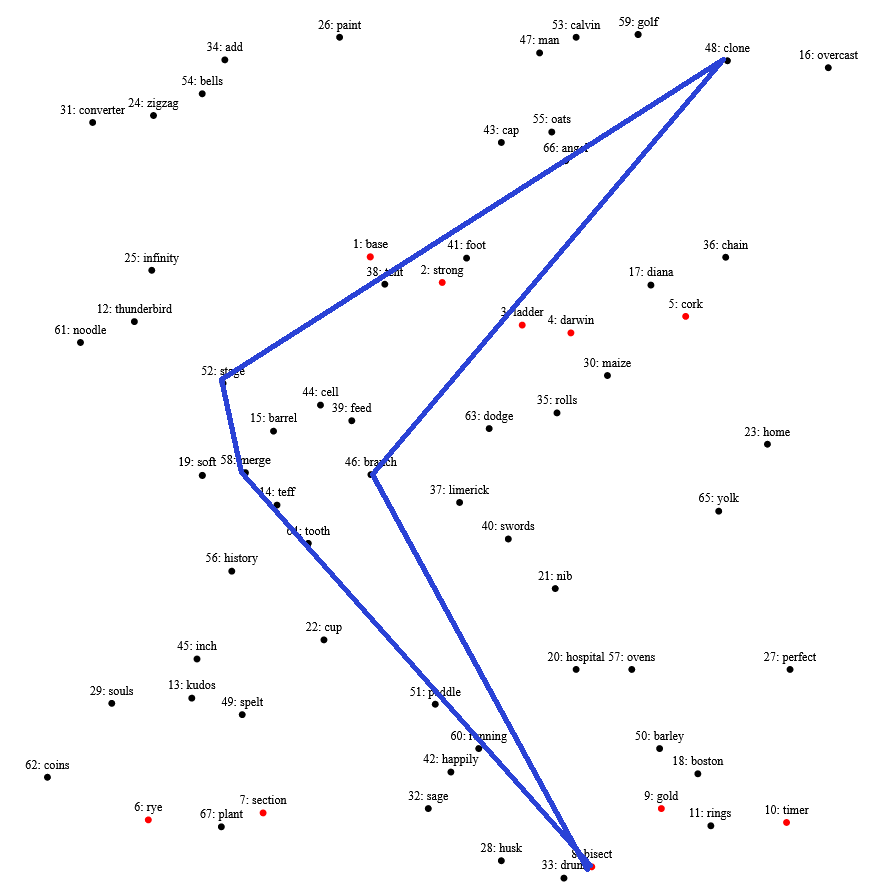
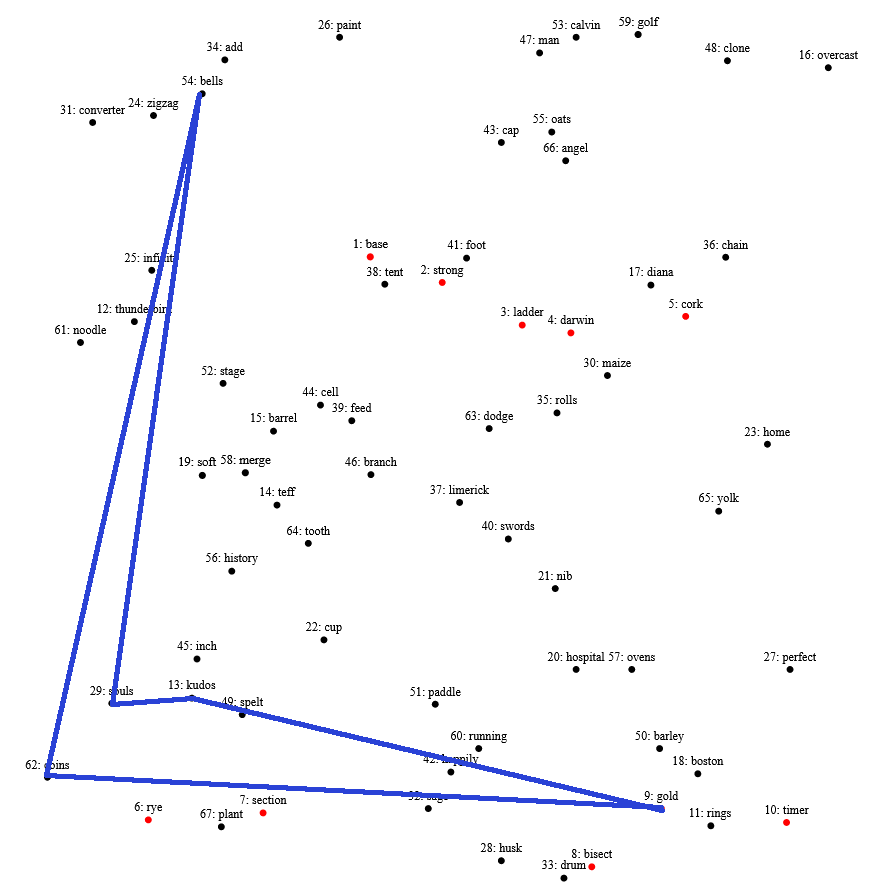
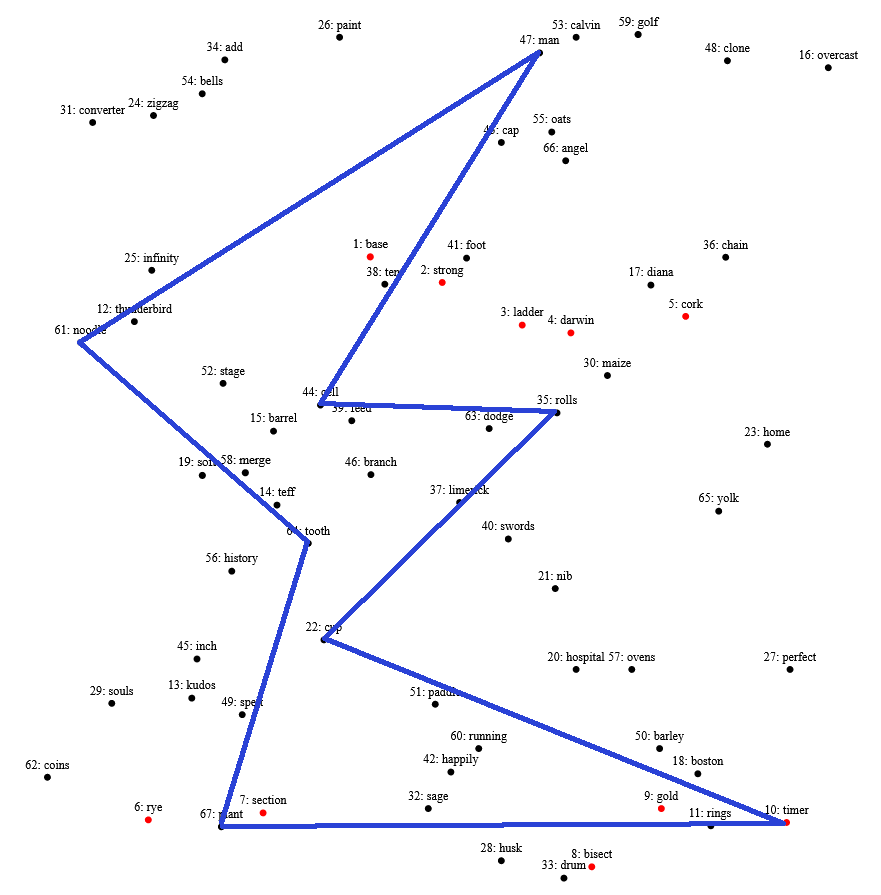
The removed items are, in the same order:
| Category | Removed point | Letter |
|---|---|---|
| Balls | 51, paddle | P |
| One Direction Songs | 25, infinity | I |
| Types of sewing stitches | 36, chain | C |
| Codenames of members of X-Men | 12, thunderbird | T |
| Towns and villanes in Ireland | 45, inch | I |
| Types of grains | 55, oats | O |
| Parts of a fountain pen | 21, nib | N |
| Git commands | 34, add | A |
| Types of video game currencies | 11, rings | R |
| Words that can follow egg | 65, yolk | Y |
Reading the first letter of each word, we get PICTIONARY. Upon submission, we receive a message asking us to submit the other phrase instead. Submitting NOT IN CYCLE asks us to submit the full 20-letter phrase. Submitting PICTIONARY NOT IN CYCLE or NOT IN CYCLE PICTIONARY tells us that we are done with this puzzle.
This leads us to realize neither PICTIONARY nor NOT IN CYCLE is the final answer to this drawing puzzle. In fact, this is a clue phrase. There is a puzzle from earlier in this hunt, Pictionary consisting of a set of drawings. The solution to that puzzle relies on creating a cycle. However, one drawing in that puzzle that was not used in that cycle. That was a RED HERRING, the answer to this puzzle which aptly describes the solving experience when forming groups.
Author's Notes
This puzzle was partially inspired by Only Connect. The answer RED HERRING was decided after we had already written the Pictionary puzzle (which initially featured a red herring that we removed because we found it cute but inelegant). I immediately snagged the answer from the answer pool to work on this puzzle. One of the initial concerns we had with this answer was getting teams to submit it if they came across it in a puzzle.
The puzzle also initially featured groups themed around dots: balls, grains, pens, video game currencies (points), and One Direction (1D) songs survived the several rounds of cuts. Other categories that were cut were islands (too many, too vague), fictional planets (quite too obvious after the other change to the puzzle), TLDs (due to Word Wide Web), words entirely composed of dots in Morse code (not fun), last word of works of Pointillism art (too obscure).
That version of the puzzle featured a multimedia set with pictures, videos, crossword clues, gifs, rebuses, and sound clips that were designed to clue individual words. Resolving each of these 60+ pieces of media, while fun, detracted from the puzzle and made it too long. It was difficult to come up with interesting clues for all the words, and the puzzle was already on the longer end, so we decided to cut that giant step.
We did the roundabout answer submission messages because it is possible to form groups without doing any drawing, or draw only two or three groups and suspect we need to use the extra points. With some tools, it’s easy to find PICTIONARY very early on in the puzzle as the answer. Thus, the first message asks us to double-back and solve the rest of the groups or draw the letters. The second message given for NOT IN CYCLE is more generous because it proves that we have formed enough groups and drawn the letters.
This mechanic of asking solvers to go back to an earlier puzzle they may not have fully solved yet is questionable and new (as far as I know). In the end, this step was well-received in testsolving, despite being "highly illegal", and so we kept it. In addition, Pictionary does not need to be fully solved -- it is enough to realize that the drawings form a cycle.